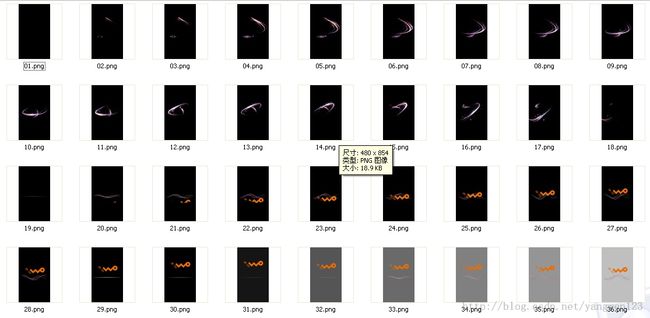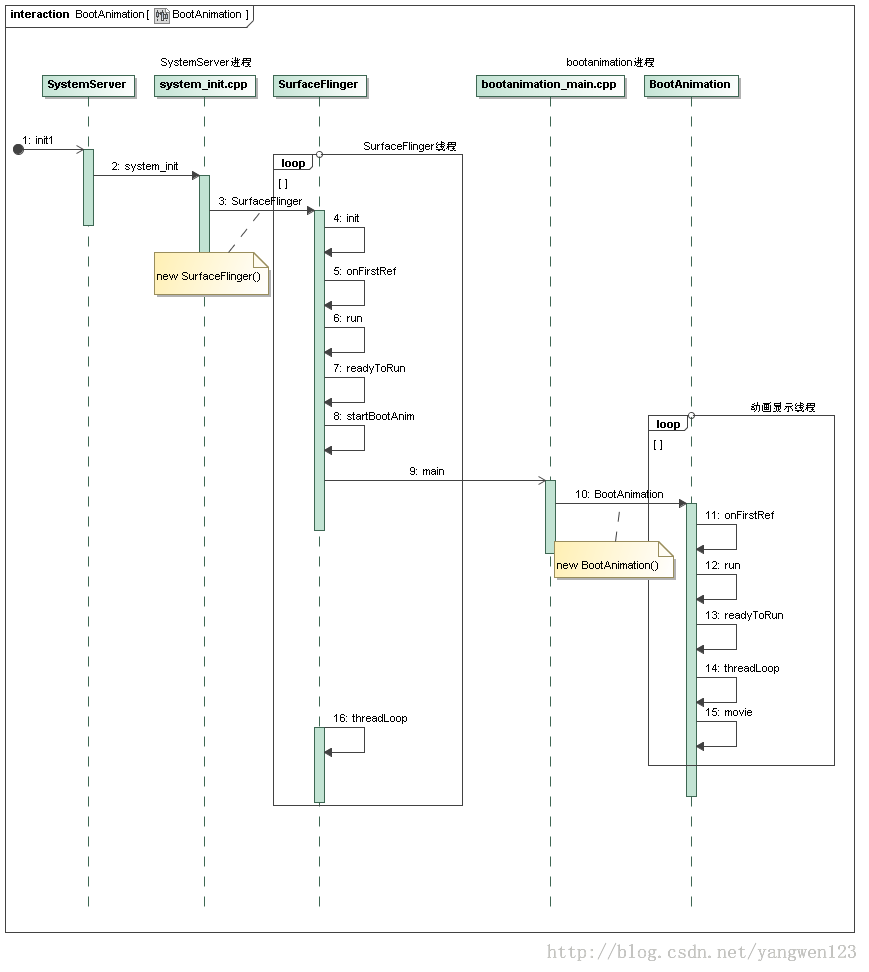Android 开关机动画显示源码分析
Android系统在启动SystemServer进程时,通过两个阶段来启动系统所有服务,在第一阶段启动本地服务,如SurfaceFlinger,SensorService等,在第二阶段则启动一系列的Java服务。开机动画是在什么时候启动的呢?通过查看源码,Android开机动画是在启动SurfaceFlinger服务时启动的。SystemServer的main函数首先调用init1来启动本地服务,init1函数通过JNI调用C语言中的system_init()函数来实现服务启动。
extern "C" status_t system_init()
{
sp<ProcessState> proc(ProcessState::self());
sp<IServiceManager> sm = defaultServiceManager();
sp<GrimReaper> grim = new GrimReaper();
sm->asBinder()->linkToDeath(grim, grim.get(), 0);
char propBuf[PROPERTY_VALUE_MAX];
property_get("system_init.startsurfaceflinger", propBuf, "1");
if (strcmp(propBuf, "1") == 0) {
// Start the SurfaceFlinger
SurfaceFlinger::instantiate();
}
...
return NO_ERROR;
} 通过调用SurfaceFlinger::instantiate()函数来启动SurfaceFlinger服务,SurfaceFlinger类继承于BinderService模板类,BinderService类的instantiate()函数就是构造对应类型的服务对象,并注册到ServiceManager进程中。
static void instantiate() { publish(); }
static status_t publish(bool allowIsolated = false) {
sp<IServiceManager> sm(defaultServiceManager());
return sm->addService(String16(SERVICE::getServiceName()), new SERVICE(), allowIsolated);
}
对于SurfaceFlinger服务来说,就是首先构造SurfaceFlinger对象,然后通过调用ServiceManger的远程Binder代理对象的addService函数来注册SurfaceFlinger服务。这里只介绍SurfaceFlinger的构造过程,对于服务注册过程,在Android服务注册完整过程源码分析中已经介绍的非常详细。
SurfaceFlinger::SurfaceFlinger()
: BnSurfaceComposer(), Thread(false),
mTransactionFlags(0),
mTransationPending(false),
mLayersRemoved(false),
mBootTime(systemTime()),
mVisibleRegionsDirty(false),
mHwWorkListDirty(false),
mElectronBeamAnimationMode(0),
mDebugRegion(0),
mDebugDDMS(0),
mDebugDisableHWC(0),
mDebugDisableTransformHint(0),
mDebugInSwapBuffers(0),
mLastSwapBufferTime(0),
mDebugInTransaction(0),
mLastTransactionTime(0),
mBootFinished(false),
mSecureFrameBuffer(0)
{
init();
} SurfaceFlinger对象实例的构造过程很简单,就是初始化一些成员变量值,然后调用init()函数来完成初始化工作
void SurfaceFlinger::init()
{
char value[PROPERTY_VALUE_MAX];
property_get("debug.sf.showupdates", value, "0");
mDebugRegion = atoi(value);
#ifdef DDMS_DEBUGGING
property_get("debug.sf.ddms", value, "0");
mDebugDDMS = atoi(value);
if (mDebugDDMS) {
DdmConnection::start(getServiceName());
}
#endif
property_get("ro.bootmode", value, "mode");
if (!(strcmp(value, "engtest")
&& strcmp(value, "special")
&& strcmp(value, "wdgreboot")
&& strcmp(value, "unknowreboot")
&& strcmp(value, "panic"))) {
SurfaceFlinger::sBootanimEnable = false;
}
} 在SurfaceFlinger的init函数中,也并没有做任何复杂工作,只是简单读取系统属性得到开机模式,来相应设置一些变量而已,比如是否显示开机动画变量sBootanimEnable。由于SurfaceFlinger继承于RefBase类,并重写了该类的onFirstRef()函数,我们知道,RefBase类的子类对象在第一次创建时,会自动调用onFirstRef()函数,因此在SurfaceFlinger对象构造完成时,将调用onFirstRef()函数。
void SurfaceFlinger::onFirstRef()
{
mEventQueue.init(this);//事件队列初始化
run("SurfaceFlinger", PRIORITY_URGENT_DISPLAY);//运行SurfaceFlinger线程
mReadyToRunBarrier.wait();
} 这里不对SurfaceFlinger的相关内容做详细介绍,本文的主要内容是介绍开机动画显示过程。由于SurfaceFlinger同时继承于线程Thread类,而且SurfaceFlinger并没有重写Thread类的run方法,因此这里调用SurfaceFlinger的run函数,其实调用的就是其父类Thread的run函数。
status_t Thread::run(const char* name, int32_t priority, size_t stack)
{
Mutex::Autolock _l(mLock);
if (mRunning) {
return INVALID_OPERATION;
}
mStatus = NO_ERROR;
mExitPending = false;
mThread = thread_id_t(-1);
mHoldSelf = this;
mRunning = true;
bool res;
if (mCanCallJava) {
res = createThreadEtc(_threadLoop,this, name, priority, stack, &mThread);
} else {
res = androidCreateRawThreadEtc(_threadLoop,this, name, priority, stack, &mThread);
}
if (res == false) {
mStatus = UNKNOWN_ERROR; // something happened!
mRunning = false;
mThread = thread_id_t(-1);
mHoldSelf.clear(); // "this" may have gone away after this.
return UNKNOWN_ERROR;
}
return NO_ERROR;
}
该函数就是创建一个线程,并运行现在执行函数_threadLoop
int Thread::_threadLoop(void* user)
{
Thread* const self = static_cast<Thread*>(user);
sp<Thread> strong(self->mHoldSelf);
wp<Thread> weak(strong);
self->mHoldSelf.clear();
#ifdef HAVE_ANDROID_OS
self->mTid = gettid();
#endif
bool first = true;
do {
bool result;
if (first) {
first = false;
self->mStatus = self->readyToRun();
result = (self->mStatus == NO_ERROR);
if (result && !self->exitPending()) {
result = self->threadLoop();
}
} else {
result = self->threadLoop();
}
{
Mutex::Autolock _l(self->mLock);
if (result == false || self->mExitPending) {
self->mExitPending = true;
self->mRunning = false;
self->mThread = thread_id_t(-1);
self->mThreadExitedCondition.broadcast();
break;
}
}
strong.clear();
strong = weak.promote();
} while(strong != 0);
return 0;
} 在线程开始运行时,变量first为true,因此会调用self->readyToRun()来做一些初始化工作,同时将变量first设置为false,在以后线程执行过程中,就反复执行self->threadLoop()了。作为Thread类的子类SurfaceFlinger重写了这两个方法,因此创建的SurfaceFlinger线程在执行前会调用SurfaceFlinger的readyToRun()函数完成初始化任务,然后反复执行SurfaceFlinger的threadLoop()函数。
status_t SurfaceFlinger::readyToRun()
{
ALOGI( "SurfaceFlinger's main thread ready to run. "
"Initializing graphics H/W...");
int dpy = 0;
{
// initialize the main display
GraphicPlane& plane(graphicPlane(dpy));
DisplayHardware* const hw = new DisplayHardware(this, dpy);
plane.setDisplayHardware(hw);
}
// create the shared control-block
mServerHeap = new MemoryHeapBase(4096,MemoryHeapBase::READ_ONLY, "SurfaceFlinger read-only heap");
ALOGE_IF(mServerHeap==0, "can't create shared memory dealer");
mServerCblk = static_cast<surface_flinger_cblk_t*>(mServerHeap->getBase());
ALOGE_IF(mServerCblk==0, "can't get to shared control block's address");
new(mServerCblk) surface_flinger_cblk_t;
// initialize primary screen
const GraphicPlane& plane(graphicPlane(dpy));
const DisplayHardware& hw = plane.displayHardware();
const uint32_t w = hw.getWidth();
const uint32_t h = hw.getHeight();
const uint32_t f = hw.getFormat();
hw.makeCurrent();
// initialize the shared control block
mServerCblk->connected |= 1<<dpy;
display_cblk_t* dcblk = mServerCblk->displays + dpy;
memset(dcblk, 0, sizeof(display_cblk_t));
dcblk->w = plane.getWidth();
dcblk->h = plane.getHeight();
dcblk->format = f;
dcblk->orientation = ISurfaceComposer::eOrientationDefault;
dcblk->xdpi = hw.getDpiX();
dcblk->ydpi = hw.getDpiY();
dcblk->fps = hw.getRefreshRate();
dcblk->density = hw.getDensity();
// Initialize OpenGL|ES
glPixelStorei(GL_UNPACK_ALIGNMENT, 4);
glPixelStorei(GL_PACK_ALIGNMENT, 4);
glEnableClientState(GL_VERTEX_ARRAY);
glShadeModel(GL_FLAT);
glDisable(GL_DITHER);
glDisable(GL_CULL_FACE);
const uint16_t g0 = pack565(0x0F,0x1F,0x0F);
const uint16_t g1 = pack565(0x17,0x2f,0x17);
const uint16_t wormholeTexData[4] = { g0, g1, g1, g0 };
glGenTextures(1, &mWormholeTexName);
glBindTexture(GL_TEXTURE_2D, mWormholeTexName);
glTexParameterx(GL_TEXTURE_2D, GL_TEXTURE_MAG_FILTER, GL_NEAREST);
glTexParameterx(GL_TEXTURE_2D, GL_TEXTURE_MIN_FILTER, GL_NEAREST);
glTexParameterx(GL_TEXTURE_2D, GL_TEXTURE_WRAP_S, GL_REPEAT);
glTexParameterx(GL_TEXTURE_2D, GL_TEXTURE_WRAP_T, GL_REPEAT);
glTexImage2D(GL_TEXTURE_2D, 0, GL_RGB, 2, 2, 0,GL_RGB, GL_UNSIGNED_SHORT_5_6_5, wormholeTexData);
const uint16_t protTexData[] = { pack565(0x03, 0x03, 0x03) };
glGenTextures(1, &mProtectedTexName);
glBindTexture(GL_TEXTURE_2D, mProtectedTexName);
glTexParameterx(GL_TEXTURE_2D, GL_TEXTURE_MAG_FILTER, GL_NEAREST);
glTexParameterx(GL_TEXTURE_2D, GL_TEXTURE_MIN_FILTER, GL_NEAREST);
glTexParameterx(GL_TEXTURE_2D, GL_TEXTURE_WRAP_S, GL_REPEAT);
glTexParameterx(GL_TEXTURE_2D, GL_TEXTURE_WRAP_T, GL_REPEAT);
glTexImage2D(GL_TEXTURE_2D, 0, GL_RGB, 1, 1, 0,GL_RGB, GL_UNSIGNED_SHORT_5_6_5, protTexData);
glViewport(0, 0, w, h);
glMatrixMode(GL_PROJECTION);
glLoadIdentity();
// put the origin in the left-bottom corner
glOrthof(0, w, 0, h, 0, 1); // l=0, r=w ; b=0, t=h
// start the EventThread
mEventThread = new EventThread(this);
mEventQueue.setEventThread(mEventThread);
hw.startSleepManagement();
/*
* We're now ready to accept clients...
*/
mReadyToRunBarrier.open();
// start boot animation
startBootAnim();
return NO_ERROR;
} 该函数首先是初始化Android的图形显示系统,启动SurfaceFlinger事件线程,这些内容只有了解了Android的显示原理及SurfaceFlinger服务之后才能理解,这里不做介绍。当显示系统初始化完毕后,调用startBootAnim()函数来显示开机动画。
void SurfaceFlinger::startBootAnim() {
// start boot animation
if(SurfaceFlinger::sBootanimEnable){
property_set("service.bootanim.exit", "0");
property_set("ctl.start", "bootanim");
}
} startBootAnim()函数比较简单,就是通过判断开机动画的变量值了决定是否显示开机动画。启动开机动画进程也是通过Android属性系统来实现的,具体启动过程可以查看 Android 系统属性SystemProperty分析。在Android系统启动脚本init.rc中配置了开机动画服务进程。
property_set("ctl.start", "bootanim")就是启动bootanim进程来显示开机动画,该进程对应的源码位于frameworks\base\cmds\bootanimation\bootanimation_main.cpp
int main(int argc, char** argv)
{
#if defined(HAVE_PTHREADS)
setpriority(PRIO_PROCESS, 0, ANDROID_PRIORITY_DISPLAY);
#endif
char value[PROPERTY_VALUE_MAX];
property_get("debug.sf.nobootanimation", value, "0");
int noBootAnimation = atoi(value);
ALOGI_IF(noBootAnimation, "boot animation disabled");
if (!noBootAnimation) {
/*modify boot animation and added shutdown animation*/
char argvtmp[2][BOOTANIMATION_PATHSET_MAX];
memset(argvtmp[0],0,BOOTANIMATION_PATHSET_MAX);
memset(argvtmp[1],0,BOOTANIMATION_PATHSET_MAX);
//没有参数时,执行开机动画,
if(argc<2){
//开机动画文件BOOTANIMATION_BOOT_FILM_PATH_DEFAULT="/system/media/bootanimation.zip"
strncpy(argvtmp[0],BOOTANIMATION_BOOT_FILM_PATH_DEFAULT,BOOTANIMATION_PATHSET_MAX);
//开机声音文件BOOTANIMATION_BOOT_SOUND_PATH_DEFAULT="/system/media/bootsound.mp3"
strncpy(argvtmp[1],BOOTANIMATION_BOOT_SOUND_PATH_DEFAULT,BOOTANIMATION_PATHSET_MAX);
}else{//否则执行关机动画
//关机动画文件BOOTANIMATION_SHUTDOWN_FILM_PATH_DEFAULT="/system/media/shutdownanimation.zip"
strncpy(argvtmp[0],BOOTANIMATION_SHUTDOWN_FILM_PATH_DEFAULT,BOOTANIMATION_PATHSET_MAX);
//关机声音文件BOOTANIMATION_SHUTDOWN_SOUND_PATH_DEFAULT="/system/media/shutdownsound.mp3"
strncpy(argvtmp[1],BOOTANIMATION_SHUTDOWN_SOUND_PATH_DEFAULT,BOOTANIMATION_PATHSET_MAX);
}
__android_log_print(ANDROID_LOG_INFO,"BootAnimation", "begine bootanimation!");
//启动Binder线程池,用于接收其他进程的请求
sp<ProcessState> proc(ProcessState::self());
ProcessState::self()->startThreadPool();
//创建BootAnimation对象
BootAnimation *boota = new BootAnimation();
String8 descname("desc.txt");
if(argc<2){//设置开机动画文件的默认路径
String8 mpath_default(BOOTANIMATION_BOOT_FILM_PATH_DEFAULT);
String8 spath_default(BOOTANIMATION_BOOT_SOUND_PATH_DEFAULT);
boota->setmoviepath_default(mpath_default);
boota->setsoundpath_default(spath_default);
//boota->setdescname_default(descname_default);
}else {//设置关机动画文件的默认路径
String8 mpath_default(BOOTANIMATION_SHUTDOWN_FILM_PATH_DEFAULT);
String8 spath_default(BOOTANIMATION_SHUTDOWN_SOUND_PATH_DEFAULT);
boota->setmoviepath_default(mpath_default);
boota->setsoundpath_default(spath_default);
//boota->setdescname_default(descname_default);
__android_log_print(ANDROID_LOG_INFO,"BootAnimation","shutdown exe bootanimation!");
}
String8 mpath(argvtmp[0]);
String8 spath(argvtmp[1]);
//设置动画的文件路径
boota->setmoviepath(mpath);
boota->setsoundpath(spath);
boota->setdescname(descname);
__android_log_print(ANDROID_LOG_INFO,"BootAnimation","%s", mpath.string());
__android_log_print(ANDROID_LOG_INFO,"BootAnimation","%s", spath.string());
sp<BootAnimation> bootsp = boota;
//将当前线程注册到Binder线程池中
IPCThreadState::self()->joinThreadPool();
}
return 0;
}
该函数构造了一个BootAnimation对象,并且为该对象设置了开关机动画及声音文件路径,同时创建了Binder线程池,并将bootanim进程的主线程注册到Binder线程池中,用于接收客户进程的Binder通信请求。
BootAnimation::BootAnimation() : Thread(false)
{
mSession = new SurfaceComposerClient();
} 在构造BootAnimation对象时,实例化SurfaceComposerClient对象,用于请求SurfaceFlinger显示开关机动画。由于BootAnimation类继承于RefBase,同时重写了onFirstRef()函数,因此在构造BootAnimation对象时,会调用该函数。
void BootAnimation::onFirstRef() {
status_t err = mSession->linkToComposerDeath(this);
ALOGE_IF(err, "linkToComposerDeath failed (%s) ", strerror(-err));
if (err == NO_ERROR) {
run("BootAnimation", PRIORITY_DISPLAY);
}
} 该函数首先为SurfaceComposerClient对象注册Binder死亡通知,然后调用BootAnimation的run方法,由于BootAnimation同时继承于Thread类,前面介绍SurfaceFlinger时已经介绍到,当某个类继承于Thread类时,当调用该类的run函数时,函数首先会执行readyToRun()函数来完成线程执行前的一些工作,然后线程反复执行threadLoop()函数,在BootAnimation类中,同样重新了这两个方法
status_t BootAnimation::readyToRun() {
//force screen display in vertical layout
mSession->setOrientation(0, 0, 0);
mAssets.addDefaultAssets();
DisplayInfo dinfo;
status_t status = session()->getDisplayInfo(0, &dinfo);
if (status)
return -1;
// create the native surface
sp<SurfaceControl> control;
if (dinfo.w > dinfo.h) {
control = session()->createSurface(0, dinfo.h, dinfo.w, PIXEL_FORMAT_RGB_565);
} else {
control = session()->createSurface(0, dinfo.w, dinfo.h, PIXEL_FORMAT_RGB_565);
}
SurfaceComposerClient::openGlobalTransaction();
control->setLayer(0x40000000);
SurfaceComposerClient::closeGlobalTransaction();
sp<Surface> s = control->getSurface();
// initialize opengl and egl
const EGLint attribs[] = {
EGL_RED_SIZE, 8,
EGL_GREEN_SIZE, 8,
EGL_BLUE_SIZE, 8,
EGL_DEPTH_SIZE, 0,
EGL_NONE
};
EGLint w, h, dummy;
EGLint numConfigs;
EGLConfig config;
EGLSurface surface;
EGLContext context;
EGLDisplay display = eglGetDisplay(EGL_DEFAULT_DISPLAY);
eglInitialize(display, 0, 0);
eglChooseConfig(display, attribs, &config, 1, &numConfigs);
surface = eglCreateWindowSurface(display, config, s.get(), NULL);
context = eglCreateContext(display, config, NULL, NULL);
eglQuerySurface(display, surface, EGL_WIDTH, &w);
eglQuerySurface(display, surface, EGL_HEIGHT, &h);
if (eglMakeCurrent(display, surface, surface, context) == EGL_FALSE)
return NO_INIT;
mDisplay = display;
mContext = context;
mSurface = surface;
mWidth = w;
mHeight = h;
mFlingerSurfaceControl = control;
mFlingerSurface = s;
mAndroidAnimation = true;
// If the device has encryption turned on or is in process
// of being encrypted we show the encrypted boot animation.
char decrypt[PROPERTY_VALUE_MAX];
property_get("vold.decrypt", decrypt, "");
bool encryptedAnimation = atoi(decrypt) != 0 || !strcmp("trigger_restart_min_framework", decrypt);
//如果"/system/media/bootanimation-encrypted.zip"文件存在或者设置的动画文件存在,或者默认动画文件存在,或者"/data/local/bootanimation.zip"文件存在,都显示开机动画文件,否则显示Android滚动字样
if ((encryptedAnimation &&
(access(SYSTEM_ENCRYPTED_BOOTANIMATION_FILE, R_OK) == 0) &&
(mZip.open(SYSTEM_ENCRYPTED_BOOTANIMATION_FILE) == NO_ERROR)) ||
((access(moviepath, R_OK) == 0) &&
(mZip.open(moviepath) == NO_ERROR)) ||
((access(movie_default_path, R_OK) == 0) &&
(mZip.open(movie_default_path) == NO_ERROR)) ||
((access(USER_BOOTANIMATION_FILE, R_OK) == 0) &&
(mZip.open(USER_BOOTANIMATION_FILE) == NO_ERROR))) {
mAndroidAnimation = false;
}
return NO_ERROR;
} 在该函数里创建SurfaceControl对象,通过SurfaceControl对象得到Surface对象,并初始化好OpenGL,同时判断动画文件是否存在,如果不存在,则设置标志位mAndroidAnimation为true,表示显示Android滚动字样。当初始化完这些必需资源后,线程进入循环执行体threadLoop()
bool BootAnimation::threadLoop()
{
bool r;
//如果mAndroidAnimation为true,表示动画文件不存在,则显示Android滚动字样
if (mAndroidAnimation) {
r = android();
} else {//显示动画
r = movie();
}
//资源回收
eglMakeCurrent(mDisplay, EGL_NO_SURFACE, EGL_NO_SURFACE, EGL_NO_CONTEXT);
eglDestroyContext(mDisplay, mContext);
eglDestroySurface(mDisplay, mSurface);
mFlingerSurface.clear();
mFlingerSurfaceControl.clear();
eglTerminate(mDisplay);
IPCThreadState::self()->stopProcess();
return r;
} 开机画面主要是由一个zip格式的压缩包bootanimation.zip组成,压缩包里面包含数张png格式的图片,还有一个desc.txt的文本文档,开机时按desc.txt里面的指令,屏幕上会按文件名称顺序连续的播放一张张的图片,就像播放原始的胶带影片一样,形成动画。desc.txt是一个保存形式为ANSI格式的文件,用于设置这个动画像素(大小),帧数,闪烁次数,文件夹名称等。内容如下:
480 854 10
p 1 2 folder1
p 0 2 folder2
480 427 30 ---这里的480代表图片的像素(大小)宽度,427代表图片的像素(大小)高度,30代表帧数;
p 1 0 part0 ---这里的p代表标志符,1代表循环次数为1次,0代表阶段间隔时间为0,part0代表对应的文件夹名,为第一阶段动画图片目录;
p 0 0 part1---这里的p代表标志符,0代表本阶段无限循环,0代表阶段间隔时间为0,part1代表对应的文件夹名,为第二阶段动画图片目录;
阶段切换间隔时间:单位是一个帧的持续时间,比如帧数是30,那么帧的持续时间就是1秒/30 = 33.3毫秒。阶段切换间隔时间期间开机动画进程进入休眠,把CPU时间让给初始化系统使用。也就是间隔长启动会快,但会影响动画效果。
folder1和folder2文件夹内包含的是两个动画的系列图片,图片为PNG格式。
bool BootAnimation::movie()
{
ZipFileRO& zip(mZip);
//获取zip压缩文件中的文件数目
size_t numEntries = zip.getNumEntries();
//打开zip压缩文件中的desc.txt文件
ZipEntryRO desc = zip.findEntryByName("desc.txt");
FileMap* descMap = zip.createEntryFileMap(desc);
ALOGE_IF(!descMap, "descMap is null");
if (!descMap) {
return false;
}
//读取desc.txt文件内容
String8 desString((char const*)descMap->getDataPtr(),descMap->getDataLength());
char const* s = desString.string();
Animation animation;
//读取persist.sys.silence属性来决定是否播放开机音乐
char silence[PROPERTY_VALUE_MAX];
property_get("persist.sys.silence", silence, "0");
if(strcmp("1", silence)==0){
// do something.
}else{
soundplay();
}
//解析desc.txt文件内容
for (;;) { //从字符串s中查找是否有字符串"\n",如果有,返回s中"\n"起始位置的指针,如果没有,返回null。
const char* endl = strstr(s, "\n");
if (!endl) break;
//取得文件一行内容
String8 line(s, endl - s);
const char* l = line.string();
int fps, width, height, count, pause;
char path[256];
char pathType;
//从文件第一行中读取宽度,高度,帧数
//480 854 10 <---> width height fps
if (sscanf(l, "%d %d %d", &width, &height, &fps) == 3) {
//LOGD("> w=%d, h=%d, fps=%d", fps, width, height);
animation.width = (width > 0 ? width : mWidth);
animation.height = (height > 0 ? height : mHeight);
animation.fps = fps;
//p 1 2 folder1 <---> pathType count pause path
}else if (sscanf(l, " %c %d %d %s", &pathType, &count, &pause, path) == 4) {
//LOGD("> type=%c, count=%d, pause=%d, path=%s", pathType, count, pause, path);
Animation::Part part;//一个part描述一个动画文件夹内容
part.playUntilComplete = pathType == 'c';
part.count = count;
part.pause = pause;
part.path = path;
animation.parts.add(part);
}
s = ++endl;
}
//读取动画个数
const size_t pcount = animation.parts.size();
//遍历zip压缩包中的所有文件
for (size_t i=0 ; i<numEntries ; i++) {
char name[256];
ZipEntryRO entry = zip.findEntryByIndex(i);
//读取压缩包中的文件名称,所在目录的路径
if (zip.getEntryFileName(entry, name, 256) == 0) {
const String8 entryName(name);
const String8 path(entryName.getPathDir());
const String8 leaf(entryName.getPathLeaf());
if (leaf.size() > 0) {
for (int j=0 ; j<pcount ; j++) {
if (path == animation.parts[j].path) {
int method;
//获取文件信息
if (zip.getEntryInfo(entry, &method, 0, 0, 0, 0, 0)) {
if (method == ZipFileRO::kCompressStored) {
FileMap* map = zip.createEntryFileMap(entry);
if (map) {
Animation::Frame frame;
frame.name = leaf;
frame.map = map;
Animation::Part& part(animation.parts.editItemAt(j));
part.frames.add(frame);
}
}
}
}
}
}
}
}
// clear screen
glShadeModel(GL_FLAT);
glDisable(GL_DITHER);
glDisable(GL_SCISSOR_TEST);
glDisable(GL_BLEND);
glClearColor(0,0,0,1);
glClear(GL_COLOR_BUFFER_BIT);
eglSwapBuffers(mDisplay, mSurface);
glBindTexture(GL_TEXTURE_2D, 0);
glEnable(GL_TEXTURE_2D);
glTexEnvx(GL_TEXTURE_ENV, GL_TEXTURE_ENV_MODE, GL_REPLACE);
glTexParameterx(GL_TEXTURE_2D, GL_TEXTURE_WRAP_S, GL_REPEAT);
glTexParameterx(GL_TEXTURE_2D, GL_TEXTURE_WRAP_T, GL_REPEAT);
glTexParameterx(GL_TEXTURE_2D, GL_TEXTURE_MIN_FILTER, GL_LINEAR);
glTexParameterx(GL_TEXTURE_2D, GL_TEXTURE_MAG_FILTER, GL_LINEAR);
const int xc = (mWidth - animation.width) / 2;
const int yc = ((mHeight - animation.height) / 2);
nsecs_t lastFrame = systemTime();
nsecs_t frameDuration = s2ns(1) / animation.fps;
Region clearReg(Rect(mWidth, mHeight));
clearReg.subtractSelf(Rect(xc, yc, xc+animation.width, yc+animation.height));
for (int i=0 ; i<pcount ; i++) {
const Animation::Part& part(animation.parts[i]);
const size_t fcount = part.frames.size();
glBindTexture(GL_TEXTURE_2D, 0);
//循环显示文件夹下的图片
for (int r=0 ; !part.count || r<part.count ; r++) {
// Exit any non playuntil complete parts immediately
if(exitPending() && !part.playUntilComplete)
break;
for (int j=0 ; j<fcount && (!exitPending() || part.playUntilComplete) ; j++) {
const Animation::Frame& frame(part.frames[j]);
nsecs_t lastFrame = systemTime();
if (r > 0) {
glBindTexture(GL_TEXTURE_2D, frame.tid);
} else {
if (part.count != 1) {
glGenTextures(1, &frame.tid);
glBindTexture(GL_TEXTURE_2D, frame.tid);
glTexParameterx(GL_TEXTURE_2D, GL_TEXTURE_MIN_FILTER, GL_LINEAR);
glTexParameterx(GL_TEXTURE_2D, GL_TEXTURE_MAG_FILTER, GL_LINEAR);
}
initTexture(frame.map->getDataPtr(),frame.map->getDataLength());
}
if (!clearReg.isEmpty()) {
Region::const_iterator head(clearReg.begin());
Region::const_iterator tail(clearReg.end());
glEnable(GL_SCISSOR_TEST);
while (head != tail) {
const Rect& r(*head++);
glScissor(r.left, mHeight - r.bottom,
r.width(), r.height());
glClear(GL_COLOR_BUFFER_BIT);
}
glDisable(GL_SCISSOR_TEST);
}
glDrawTexiOES(xc, yc, 0, animation.width, animation.height);
eglSwapBuffers(mDisplay, mSurface);
nsecs_t now = systemTime();
nsecs_t delay = frameDuration - (now - lastFrame);
//ALOGD("%lld, %lld", ns2ms(now - lastFrame), ns2ms(delay));
lastFrame = now;
if (delay > 0) {
struct timespec spec;
spec.tv_sec = (now + delay) / 1000000000;
spec.tv_nsec = (now + delay) % 1000000000;
int err;
do {
err = clock_nanosleep(CLOCK_MONOTONIC, TIMER_ABSTIME, &spec, NULL);
} while (err<0 && errno == EINTR);
}
checkExit();
}
usleep(part.pause * ns2us(frameDuration));
// For infinite parts, we've now played them at least once, so perhaps exit
if(exitPending() && !part.count)
break;
}
// free the textures for this part
if (part.count != 1) {
for (int j=0 ; j<fcount ; j++) {
const Animation::Frame& frame(part.frames[j]);
glDeleteTextures(1, &frame.tid);
}
}
}
//停止播放开机音乐
soundstop();
return false;
} 开机音乐播放过程
bool BootAnimation::soundplay()
{
mp = NULL;
if(soundpath.length() == 0){
__android_log_print(ANDROID_LOG_ERROR, LOG_TAG, "sound resource is not right.");
return false;
}
//打开设置的开机音乐文件
int fd = open(soundpath.string(), O_RDONLY);
if(fd == -1){
__android_log_print(ANDROID_LOG_WARN, LOG_TAG, "boot animation play default source.");
close(fd);
//如果没有设置开机音乐文件路径,则打开默认的开机音乐文件
fd = open(sound_default_path.string(),O_RDONLY);
if(fd == -1){
close(fd);
__android_log_print(ANDROID_LOG_ERROR, LOG_TAG, "can not find bootanimation resource....");
return false;
}
}
mp = new MediaPlayer();
mp->setDataSource(fd, 0, 0x7ffffffffffffffLL);
mp->setAudioStreamType(/*AUDIO_STREAM_MUSIC*/AUDIO_STREAM_SYSTEM);
mp->prepare();
mp->start();
return false;
}
整个开关机动画就完成了,那关机动画是如何启动的呢?下一篇继续介绍Android系统的关机流程!



